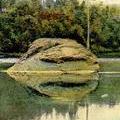 The Council fire cast weird shadows amongst the trees and the waters of the river reflected its glow. The Chieftain of the Abenakai tribe, tall and commanding, with flashing eyes, but features calm and immovable, stood in the midst of the fire-lit circle. Addressing his tribesmen the Chieftain spoke thus:
The Council fire cast weird shadows amongst the trees and the waters of the river reflected its glow. The Chieftain of the Abenakai tribe, tall and commanding, with flashing eyes, but features calm and immovable, stood in the midst of the fire-lit circle. Addressing his tribesmen the Chieftain spoke thus:
"The die is cast. Our enemy, the Iroquois, has claimed the right of the valley of the St. Francis for their hunting grounds. We know that this country is ours." His hands were extended and he pointed to the north and south, the east and west, to give emphasis to his words.
High-Brow, Chief of the Iroquois, sprang to his feet. "My brother, Tall-Feather, has spoken. The race of endurance shall take place. He who wins shall give to his tribe possession of lands now in dispute. My word is spoken."
The hostile bands of Abenakai and Iroquois had met at Skaswantegon (The place where we smoke), the point of land at the conjunction of the Magog and St. Francis rivers within the limits of the city of Sherbrooke, and near the Canadian National Railway bridge that spans the river.
Possession of hunting lands in the richly forested valley of the St. Francis had long been contested, but now the decision was made to have the question settled. Two warriors were chosen, one from each tribe, to settle the dispute in a primitive, but somewhat dramatic way. The braves stepped forward and stood in the firelight, quietly awaiting final commands from their respective chiefs.
The task put upon them was to run around the rock that stood alone, except for a pine tree that clung to it, until one had become victor. He who should have the most endurance would claim the scalp of the victim, and win for his tribe the supremacy of the valley. It was a race to the death, but speed and endurance was to them a game in which the best man would win.
At break of day Tall-Feather, the Abenakai, and High-Brow, the Iroquois, accompanied by their warriors, went down to the river bank a distance of little more than a half-mile from the confluence of the two rivers. There they gathered, each tribe facing the place where the warriors stood awaiting the command to begin their race. Their figures, silhouetted against the eastern sky now lighted with the morning sun rising from behind the Hills of Stoke, presented a dramatic picture.
Suddenly and with no commotion two forms, lithe and brown, sprang from among their comrades, threw themselves into the river, then started their race around the rock on the small island. Silent and tense the Abenakis watched the contestants. Ah, one has fallen! He is up again and running. The other falls... and so the race goes on until the Iroquois stumbles, rises, pauses a second, then rolls into the shallow water. The Abenakai grasps his victim, procures the scalp, then stands with folded arms, flashing eyes, and triumphant bearing, while shouts of joy and dismay mingle. No word is spoken; there is no need; he, like all Abenakis, is silent in times of triumph as well as in suffering. But the warrior has won for his tribe the magnificent Valley of the St. Francis River!
Source: Bertha Weston Price, Legends of Our Lakes and Rivers, Lennoxville, 1937, 17-19.